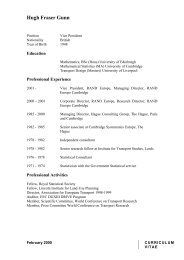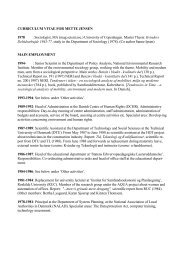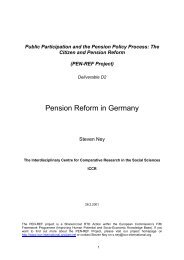The Housing Dimension of Welfare Reform - the ICCR
The Housing Dimension of Welfare Reform - the ICCR
The Housing Dimension of Welfare Reform - the ICCR
Create successful ePaper yourself
Turn your PDF publications into a flip-book with our unique Google optimized e-Paper software.
4.2 Milestones for a comprehensive welfare policy reform and housing<br />
4.2.1 Overcoming income poverty and social exclusion<br />
Income poverty is largely a transient, albeit quite dispersed,<br />
phenomenon. In 1997 just over 10 per cent <strong>of</strong> <strong>the</strong> population <strong>of</strong> <strong>the</strong><br />
countries under study had been poor for more than three years. At <strong>the</strong><br />
same time, around 30 per cent had experienced poverty at some time<br />
during <strong>the</strong> years 1994-1997. <strong>The</strong> risk <strong>of</strong> becoming and remaining poor<br />
shows significant country variation. Thus, for instance, while in Denmark<br />
only one in five <strong>of</strong> those experiencing poverty have been poor throughout<br />
<strong>the</strong> period 1994-1997, <strong>the</strong> respective ratio in France is one in two!<br />
Despite this variation <strong>the</strong> pathways into poverty are quite similar across<br />
countries. By far <strong>the</strong> strongest cause <strong>of</strong> income poverty is unemployment<br />
or inactivity. Ano<strong>the</strong>r strong determinant <strong>of</strong> entry into poverty is<br />
connected to <strong>the</strong> educational level <strong>of</strong> <strong>the</strong> household.<br />
Many <strong>of</strong> <strong>the</strong> cross-sectional comparative findings about income poverty –<br />
for instance with regard to <strong>the</strong> significance <strong>of</strong> <strong>the</strong> age or gender <strong>of</strong> <strong>the</strong><br />
main earner <strong>of</strong> <strong>the</strong> household, <strong>the</strong> role <strong>of</strong> housing deprivation or <strong>of</strong> <strong>the</strong><br />
number <strong>of</strong> children – are to be explained by country-specific patterns <strong>of</strong><br />
inclusion and exclusion that operate through or in interaction with <strong>the</strong><br />
educational system and <strong>the</strong> labour market. Ins<strong>of</strong>ar as exit from poverty is<br />
concerned, <strong>the</strong> most significant factor in this respect is <strong>the</strong> length <strong>of</strong> time<br />
spent in poverty. <strong>The</strong> longer <strong>the</strong> time spent in poverty <strong>the</strong> more difficult<br />
it is to come out <strong>of</strong> <strong>the</strong> poverty trap.<br />
Persons living in persistent poverty and facing cumulative non-monetary<br />
deprivation are a small minority. Across <strong>the</strong> EU <strong>the</strong>y only amount to two<br />
percent: <strong>the</strong>y make up five per cent <strong>of</strong> <strong>the</strong> population in Ireland but only<br />
one per cent <strong>of</strong> <strong>the</strong> population in <strong>the</strong> U.K. and Austria. Despite this group<br />
being a comparatively small minority (even among <strong>the</strong> persistently poor),<br />
<strong>the</strong>y constitute a new kind <strong>of</strong> challenge for social policies and welfare<br />
reform.<br />
What do we learn from <strong>the</strong> above findings?<br />
Probably <strong>the</strong> first and most important conclusion to draw is that social<br />
policy must continue to invest in basic social infrastructures, like<br />
education or health, and to support an inclusive labour market and <strong>the</strong><br />
provision <strong>of</strong> jobs. Lack and loss <strong>of</strong> educational capital but also labour<br />
resources are <strong>the</strong> main causes <strong>of</strong> income poverty. Prevention measures or<br />
EUROHOME-IMPACT FINAL REPORT 66









